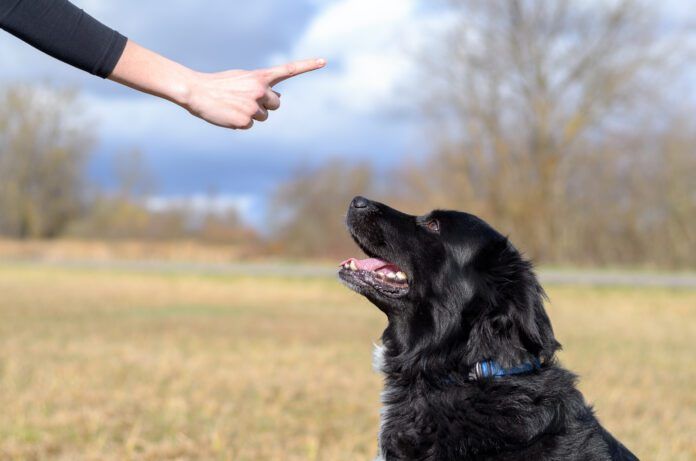Finding the right dog trainer is essential when looking to provide quality education and guidance for your dog or puppy or to address specific behavioral concerns you might have. However, navigating the dog training industry can be stressful and confusing when you encounter so many different philosophies, training methods, and points of view.
There are two main camps when it comes to dog training methods: Positive reinforcement trainers (other descriptors include force free or fear-free) and balanced dog trainers (other descriptors include dominance, aversive, punishment, or compulsion-based training). The focus of this article is to delve into balanced dog training, what it is, and why balanced training is not recommended. So, what is balanced dog training and what does science have to say about its use.
What is Balanced Dog Training?
The term “balanced dog training” is often misunderstood to mean taking a holistic approach to teaching dogs. However, in the dog training world “balanced” refers to the use of both aversive and non-aversive training methods.
As mentioned above, the majority of dog trainers can be divided into those that utilize only non-aversive methods (i.e. positive reinforcement trainers) and those that utilize a mix of non-aversive and aversive methods (i.e. balanced trainers). Both groups follow the work of psychologist B.F. Skinner, whose theory of operant conditioning divides experiences that shape behavior into four quadrants. Non-aversive trainers use two of the four quadrants: positive reinforcement (adding a rewarding stimulus to increase the likelihood of a behavior being repeated) and negative punishment (removing a rewarding stimulus to decrease the likelihood of a behavior being repeated).
Balanced dog trainers use these two quadrants as well as the remaining two: positive punishment (adding an unpleasant stimulus to decrease the likelihood a behavior will be repeated) and negative reinforcement (removing an unpleasant stimulus to increase the likelihood a behavior will be repeated).
| QUADRANTS OF OPERANT CONDITIONING | |
| Positive Reinforcement (R+)
Add something good |
Positive Punishment (P+)
Add something bad |
| Negative Reinforcement (R-)
Remove something bad |
Negative Punishment (P-)
Remove something good |
What Does Science Say About Balanced Dog Training?
The scientific community has paid increased attention to the ethical and welfare implications of different dog training methods in recent years. In light of this, a growing body of research is showing that dogs trained using aversive techniques (e.g. leash jerks with a choke or prong collar, shock delivery through e-collars, hitting or yelling at the dog) experience poorer welfare both within and outside the training context compared to dogs trained with reward-based (positive reinforcement) methods (Cooper et al., 2014; de Castro et al., 2020).
Although positive punishment in dog training has been shown to be effective, research has demonstrated that it’s no more effective than positive reinforcement. For example, in stopping problematic chasing behavior, the use of e-collars did not lead to significantly higher rates of owner-reported success than solely rewards-based (non-aversive) methods in a study of sheep chasing (Cooper et al., 2014). Dogs trained with aversive methods have often shown more stress-related behaviors such as yawning, backward-oriented ears, or avoidance behaviors than those in non-aversive conditions.
Studies have shown that, beyond immediate welfare effects, dogs exposed to aversive training methods were less successful at completing a novel training task and showed a more pessimistic bias on a spatial cognitive bias test than those trained with non-aversive methods. They were also less interactive during play solicited by an owner, less likely to interact with a stranger in a relaxed environment, spent less time gazing at their owners during training, and showed avoidance behavior whereas dogs trained using non-aversive methods did not (Johnson & Wynne, 2024).
The majority of research suggests that dog training methods based on positive reinforcement are less stressful, more effective, more humane, and do not negatively impact welfare or the human-animal bond (China et al., 2020). In recognition of this, prominent animal welfare and behavior organizations around the world have released position statements on humane dog training supporting the use of positive reinforcement and avoiding the use of aversives. These include the American Veterinary Society of Animal Behavior and the Animal Behavior Society.
How to Effectively and Humanely Modify Undesirable Behavior in Dogs
The most effective and humane way to train or modify undesirable behavior in dogs is to use a combination of positive reinforcement, negative punishment, and appropriate management strategies. These approaches are backed by a body of research in learning theory and applied behavior analysis and are widely endorsed by animal behavior and veterinary experts and organizations worldwide.
Positive Reinforcement (R+)
Positive reinforcement involves adding something the dog values (e.g. treat, praise, or pat) immediately following a desired behavior to increase the likelihood that behavior will be repeated. For example:
- Giving the dog a treat when they sit instead of jumping
- Offering praise or a pat when the dog is lying calmly on their bed
By consistently reinforcing desired behavior you can teach your dog what to do rather than just trying to stop them doing what you don’t want them to. This strategy builds trust and a positive association, strengthening the bond between you and your dog.
Negative Punishment (P-)
Negative punishment involves removing access to something the dog wants—without using fear or intimidation—to decrease the likelihood of an undesirable behavior being repeated. For example:
- Turning away and removing attention when your dog jumps up
- Pausing play when your puppy mouths too hard
This teaches your dog that certain behaviors result in the loss of rewards, encouraging them to choose alternative behaviors that keep the good things coming.
Environmental Management
Managing the environment helps set dogs up for success by helping to prevent them rehearsing unwanted behaviors. Effective management reduces triggers to problem behaviors (e.g. closing blinds to reduce reactive barking to passersby), prevents reinforcement of undesired behavior (e.g. using baby gates to stop access to the bins) and supports learning by helping the dog consistently practice appropriate behaviors. It’s important to consistently teach your dog desired behaviors through positive reinforcement in conjunction with environmental management.
This humane and evidence-based approach works because it promotes long-term behavior change, avoids the risks of positive punishment (such as fear, stress, and aggression) and strengthens the bond between owner and dog. Focusing on positive reinforcement, kind guidance, and thoughtful management helps dogs learn more effectively and supports their emotional and physical wellbeing.
References
China, L., Mills, D. S., & Cooper, J. J. (2020). Efficacy of dog training with and without remote electronic collars vs. a focus on positive reinforcement. Frontiers in Veterinary Science, 7, 547533.
Cooper, J. J., Cracknell, N., Hardiman, J., Wright, H., & Mills, D. (2014). The welfare consequences and efficacy of training pet dogs with remote electronic training collars in comparison to reward based training. PloS one, 9(9), e102722.
de Castro, A. C. V., Fuchs, D., Morello, G. M., Pastur, S., de Sousa, L., & Olsson, I. A. S. (2020). Does training method matter? Evidence for the negative impact of aversive-based methods on companion dog welfare. Plos one, 15(12), e0225023.
Johnson, A. C., & Wynne, C. D. (2024). Training Methods Used by Dog Guardians in the United States: Prevalence, Sources of Information, and Reasons for Use. Animals, 14(9), 1310.






